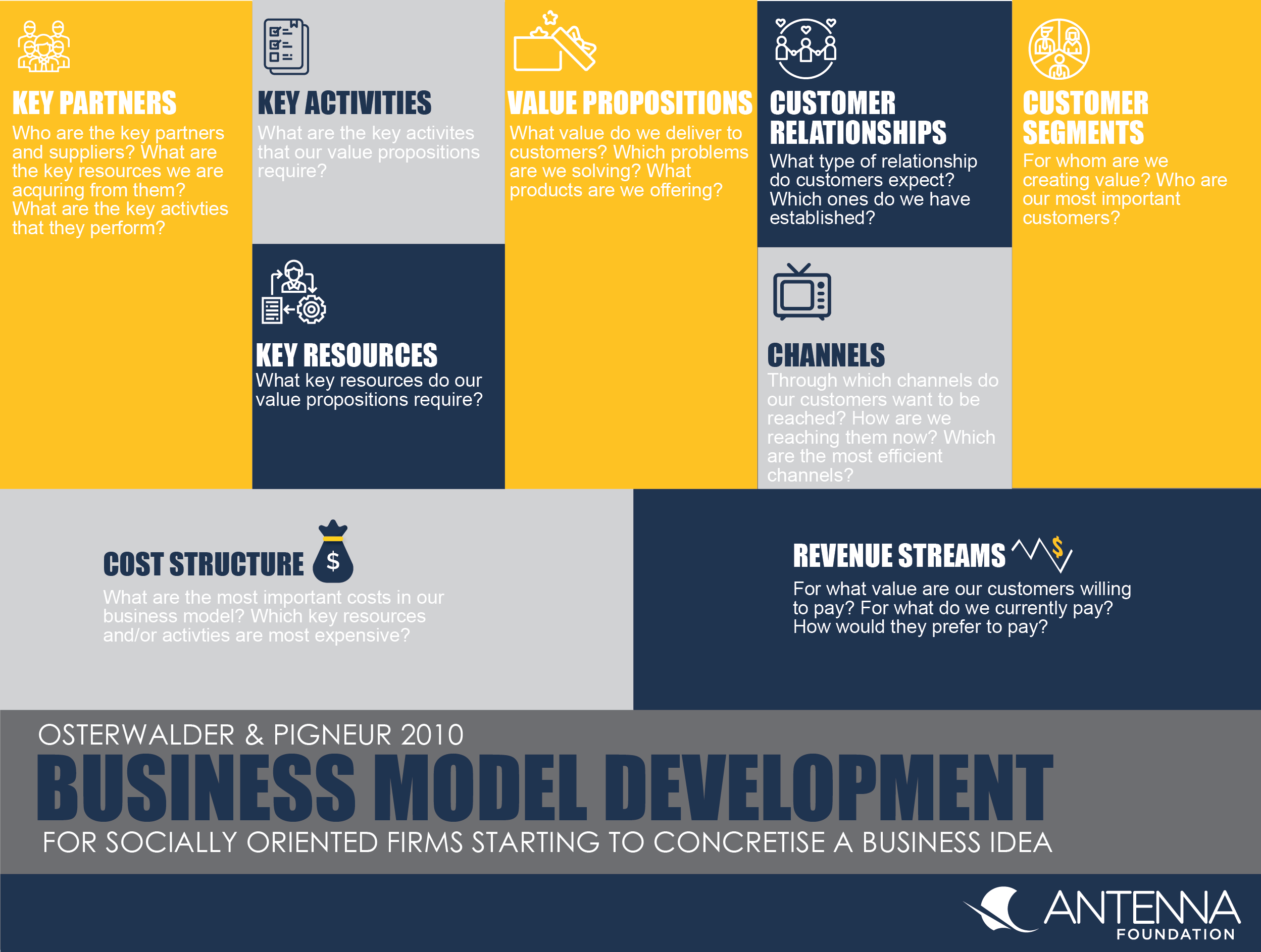Executive Summary

A business model is a conceptual framework to describe how a social enterprise, start-up or NGO creates, captures and delivers value. The Business Model Canvas (BMC) developed by Osterwalder and Pigneur (2010) serves as hands-on tool to design truly customer oriented business models to meet needs in the market. However, it also covers the aspects of customer segmentation, customer relations, and revenue streams etc. to translate a business idea into a practical business model.
The business model development factsheet provides you with an overview on how to apply the Business Model Canvas. In order to conceptualize an in-depth business model, a broad range of tools from the blueprint and validate phase factsheets are available that have also to be taken into consideration.
Subscribe here to the new Sanitation and Water Entrepreneurship Pact (SWEP) newsletter. SWEP is a network of organizations joining hands to help entrepreneurs design and develop lasting water and sanitation businesses.
What is a business model and why is it important for your business?
The term business model is widely used in theory and practice and reflects core aspects of a business as such. Osterwalder and Pigneur describe it as “[…] the rational of how an organization creates, delivers and captures value” (2010, p.14). To translate these 3 core tasks into concrete building blocks they developed the Business Model Canvas. The Business Model Canvas comprising of customer segments, value propositions, (distribution) channels, customer relationships, revenue streams, key resources, key activities, key partnerships and cost structure. This method can help safe water businesses to capture the strategy of how to create value for specific target groups, called customer segments and how to reach these customer segments with safe water or household water treatment solution (HWTS) at what price. An important dimension at an early stage is to determine the revenue streams so that the business can become cost-covering or profitable. In a next step, business model covers the aspects of what resources are needed, how to finance the business, with whom to collaborate in order to make the business work etc. When reflecting on your existing business or defining a new idea it is crucial to address these topics, specifically when you are working in the complex BoP market.
For whom is business model development essential?
Developing a business model is essential for profit and socially oriented safe water firms who are starting to concretise a business idea. It will help to assess and refine the business idea as well as reflecting and improving the model of a current business. It is applicable for profit-oriented operations as well as for not-for profit oriented ones.
How to create a new business model or refine an existing one?
With the help of the prominently used Business Model Canvas (BMC) (OSTERWALDER & PIGNEUR 2010), a company can refine, reflect or define its business model and take strategic decisions on how to proceed and implement its developed ideas. The goal of the BMC is to assist water entrepreneurs in understanding their business idea and how the business operates to encourage discussions, foster analysis and leverage creativity to design a business model that works.
A thorough explanation of the different building blocks of the Business Model Canvas can be found here.
To further explore the core elements of your business model, we refer to the other tools of the blueprint phase of this toolbox: value proposition, value creation, simple vs. complex business models, innovative ways to reach non-users and retailers and mobile sales force.
But first comes first: developing a business model in practice:
During workshops, gathering different stakeholders, you can discuss how your business model can be developed/improved to create a unique business model by using the BMC:
- See here how it can be done.
- Use this extensive step-by-step description of how to identify the different building blocks of the BMC in 20 minutes here.
- An online template version to work with can be found here.
- Interesting information about business model creation here.
- Gain inspiration with the toolkit for particular water and sanitation business development:
Having brainstormed and filled out the BMC for your company is the first step towards a successful business. But having a BMC is not the end of the work, rather the work starts now: You have to prototype and validate your business ideas to see how they perform in the real world and adjusted to the needs of your customers (see tool on human centred design).
How to Design a Winning Business Model
3 Tools to Visualize your Start-Up’s Business Model
The Concept of a Business Model
How to Test Your Idea: Start with the Most Critical Hypotheses
Business Model Canvas
The PPPCanvas
Business Models in Food and Water PPPs
This publication scanned the business models of 29 PPPs in Food Security and 13 PPPs in Sustainable Water to better understand their business models with special focus on the inclusiveness and risk management.
PPPLab Food & Water (2016): Business Models in Food and Water PPPs. URL [Accessed: 09.08.2018]Business Model Generation: A Handbook for Visionaries, Game Changers, and Challengers
Business Model Generation is a handbook for visionaries, game changers, and challengers striving to defy outmoded business models and design tomorrow's enterprises. If your organization needs to adapt to harsh new realities, but you don't yet have a strategy that will get you out in front of your competitors, you need Business Model Generation. The book features practical innovation techniques designed for doers, it is for those ready to abandon outmoded thinking and embrace new models of value creation.
OSTERWALDER, A. and PIGNEUR, Y. (2013): Business Model Generation: A Handbook for Visionaries, Game Changers, and Challengers. John Wiley & Sons URL [Accessed: 09.08.2018]Water Business Kit Kenya: A guide to starting your own water treatment and vending business
The IFC publications provides hands-on insights and checklists for developing a safe water business. The theoretical information is illustrated by examples and a case study in Kenya.
International Finance Cooperation (IFC) (2013): Water Business Kit Kenya: A guide to starting your own water treatment and vending business. Washington, D.C.: URL [Accessed: 09.08.2018]

